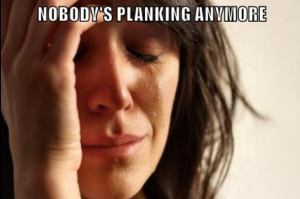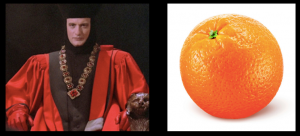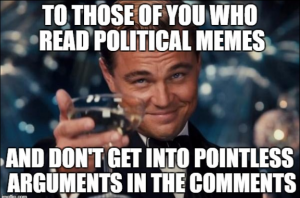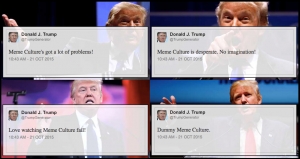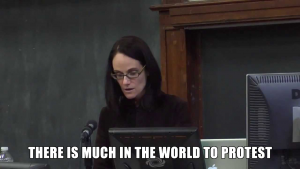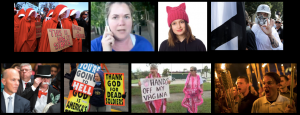Dank Memes and Tactical Media
Posted by tmemmott in Blog, Research, on August 25, 2018The text (*script) from my presentation at the Electronic Literature Organization Conference 2018.
It’s not quite a paper, which is why I call it a script. But, it does reflect my ongoing research into meme cultures.
DANK MEMES AND TACTICAL MEDIA
GOLDEN AGE
The golden age of memes is over.
Long gone are the halcyon days of Bad Luck Brian and Good Guy Greg; of Overly Attached Girlfriend and the Most Interesting Man in the World.
Nobody’s planking anymore.
The meme as a forum and formula for innocuous adolescent falderal has for the most part been lost. The joy is gone.
I remember being told, 6, 7 years ago, when I began doing research into internet meme cultures, that memes were dead; that they had run their course as a phenomenon of digital culture, and, in essence, I was wasting my time studying them. The problem here — in considering memes dead, or unworthy of critical study is based in their almost immediate dismissal as social media detritus, which ignores their gestic qualities, their performance as vernacular ekphrasis, their participation as public discourse, and is, perhaps, connected to elitist notions of language arts.
I can assure you that, though we may have passed from the golden age, meme culture is very much alive. That said, the landscape and economy for memes — their production, their exchange — has changed drastically.
This is the age of QAnon and Trump.
Scumbag Steve has been replaced by D-bag Donald.
Pepe the frog has been abducted by white nationalists.
In essence, the banality of memes, which had been their strength as an internet vernacular, has been replaced by urges and urgencies, expediency, and socio-political futility. They’ve lost their sense of humor. Memes are now serious business.
Memes have found politics.
For this talk I am going to focus primarily on the current meme culture of Twitter, which seems apropo since our feckless leader has chosen Twitter as his principal venue for communication … and by communication I mean distraction, propaganda, and incitement.
Before moving on, I must warn you, many of the memes I will be showing are offensive and, by all means, they do not reflect my feelings or political inclinations.
(*I have exclude the over 75 political memes I cycled through for most of the talk)
TWITTER AND THE DEMOCRATIZATION OF TROLLING
When Trump descended the golden escalator in June of 2015 something snapped. Everyone, it seems, was given the license to troll. Or, perhaps, with the xenophobia drenched declaration of his candidacy Trump brought out the best … troll … in all of us.
Before moving on, let’s consider the Twitter platform for a moment. The functionality of Twitter produces very different social alignments than, say, Facebook. On Facebook, one “friends” another, which produces an implied social relationship, if not social contract. On Twitter, one “follows” … which has very different implications — following the leader, following behind, following as an expression of interest, perhaps for research, or stalking. One doesn’t friend their stalker. But, one might follow a troll.
We could say that Facebook is circular — circles of friends, circles of friends of friends; where, Twitter is linear if not tangential — based more upon trajectories … or,maybe projectories. In fact, at some level, calling Twitter social media is a stretch. Where Facebook as a platform is designed to at least feel that social relationships are significant to its ontology; Twitter is designed, it seems, to facilitate acts of perlustration and avocation.
There is something eremitic about Twitter. And, the position of the troll is something like the troll found in Three Billy Goats Gruff. Lying in wait for those libtards, demorats, and antifa to cross its Twitter feed bridge. Only popping out to attack; to tweet out some political meme they’ve lifted from elsewhere or to make some supposedly terse remark. Finally suspended from the platform when the billy goats turn out to be bigger trolls than he.
As a platform, Twitter democratize trolling by producing individuated “proxy sovereigns,” to borrow a term from Butler — dogmatic cutouts, hyper-partisan stand-ins — and, the meme becomes the privileged tool for the dissemination of rote idioms. The walking dead idioms of the chosen cult.
As agents of partisan dogma, these “proxy sovereigns”, or cult practitioners perform the overt yet sublimated will of political rhetoric. The “proxy sovereign” imagines herself as privileged; an extension of the demagogue. Individuated, but part of the collective body of the leader. And, the ingemination of memes, which to be certain is the very condition for a meme becoming a meme, produces a subjective, collective, projective chant. As if, say, witnessing for Trump.
As such, the communication model for political memes does not have the same intent or economy of (can we say) traditional memes. Rather, political memes operate on the conditions of affirmation and rejection — the affirmation or rejection of a particular political stance. Because of this, political memes exist in polemical bubbles, which makes them perhaps more tactit than tactical; imbued with epic caricature.
RHETORICITY AND DOGMA — GESTICS, A TACTICAL PROBLEM
Memes, in particular image-macro memes can be understood perhaps as bricolage; in that, to quote Levi-Strauss, they “ … construct a system of paradigms with the fragments of syntagmatic chains.” The function of the caption is to narrativize or produce commentary on the tableau; narratives or commentaries that do not so much produce “story” as reinforce, or give intonation to the embedded expression, the face, the subject. In essence,to provide context for alienation,in the Brechtian sense.
In a meme like Bad Luck Brian or Condescending Wonka the intonation of the paradigm is made clear through the turn between the top and bottom captions… For Bad Luck Brian it’s top caption — major life achievement contrasted with the bottom caption — abject failure; for Condescending Wonka it’s top caption — rhetorical question contrasted with bottom caption — a snarky response. This formula should be evident to anyone that has been on the internet for more than 10 to 15 minutes.
Political memes as a whole do not have such a simple, iterative, malleable formula. But, they do most certainly have a formula.
Rarely funny, highly partisan political memes maintain a level juvenility; but rather than being somewhat lighthearted, the juvenility is expressed through a hyperbolic and superficially partisan performance of the “alienation effect” — an overt othering of the opponent, the other party; pointing out the strangeness, the corruption, the “un-americanness” of this other.
One may call Trump “Cheeto Jesus”, another may call Hillary Clinton “Killary.” One may focus on mainstream media as fake news, another may question Michelle Obama’s gender. Conspiracy theories abound.
Political memes run from the ludicrous to the profane, but what they have in common is their intent to incite. This is their speculative “alienation” capital. That said, they, in actuality, have little gestic capacity — affect through combined gesture and attitude. Rather, their effect; their “alienation effect” is contained — reflexive rather than projective. They, for the most part, only work to reify an already held position. And, from the opposing position, they only work to rarefy — to further marginalize the projective position.
In essence, this produces a sort of gestic nullification. A sort of silence. Again, perhaps, more tacit than tactical.
On Twitter, it would seem that political memes serve to reduce political thought to the adolescent, where debate is impossible and actual policy has no place. Memes, in general are resistant to such things anyway.
TRANSFER REPLACES DISCOURSE
The biggest political meme on Twitter is by far ——- Trump himself. He’s huuuuge!
In fact,we might want to call Trump’s own Twitter practice the most successful Netprov ever.
For sure, Trump’s campaign, presidency, and Twitter activity has made him on of the largest meme generators….
With almost 54 million followers (and probably only 53 million of those bots [joking]) , Trump has developed a Twitter persona that conspiracy theorist, and self proclaimed “performance artist” Alex Jones could only ever hope to achieve. Still, one has to consider how many of Trump’s followers are not following because they support him, but are following him for his masterful performance as internet troll, or for the opportunity to troll the troll.
I’d like here to memetically quote the first line from the introduction to Rita Raley’s “Tactical Media”.
Trump’s posturing is both a positive and negative attractor. As both the left and right are worked up to a froth — the left tries desperately to rarefy; the right feels reified. In either case, memes will be generated. And, one must wonder, with all of this energy put into the production of digital objects if hashtag and meme-based activism is enough to really affect change.
Or, when dog whistles become bull horns are, we all introduced into a sort of real world political LARPing, in which we assume the most base, idealistic, prurient, romantic, characters of are chosen ideology; caricatures of our values? In essences, becoming memes rather than using them; or, using performative memes to become what we are.
